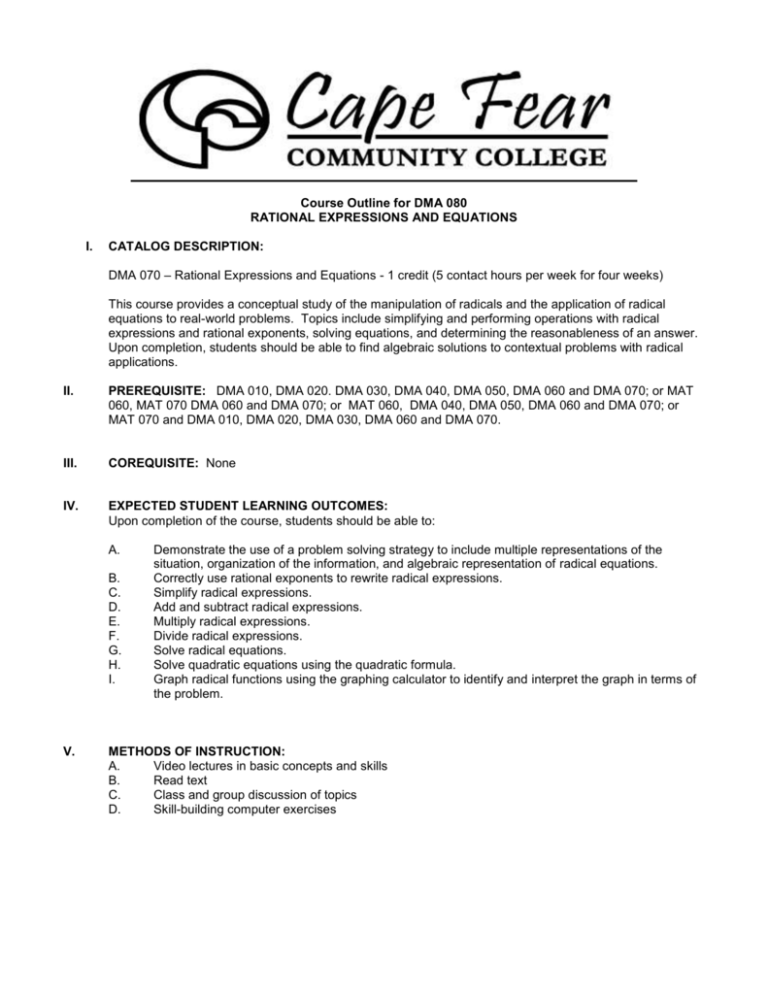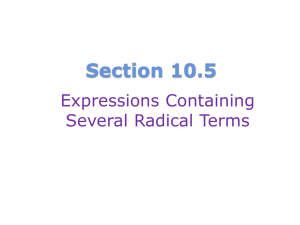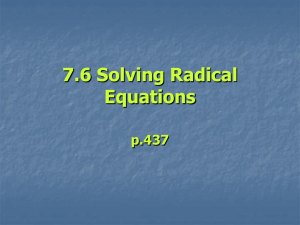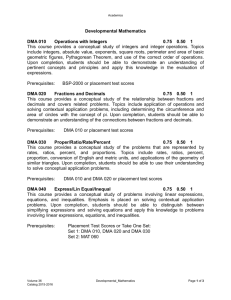
Course Outline for DMA 080
RATIONAL EXPRESSIONS AND EQUATIONS
I.
CATALOG DESCRIPTION:
DMA 070 – Rational Expressions and Equations - 1 credit (5 contact hours per week for four weeks)
This course provides a conceptual study of the manipulation of radicals and the application of radical
equations to real-world problems. Topics include simplifying and performing operations with radical
expressions and rational exponents, solving equations, and determining the reasonableness of an answer.
Upon completion, students should be able to find algebraic solutions to contextual problems with radical
applications.
II.
PREREQUISITE: DMA 010, DMA 020. DMA 030, DMA 040, DMA 050, DMA 060 and DMA 070; or MAT
060, MAT 070 DMA 060 and DMA 070; or MAT 060, DMA 040, DMA 050, DMA 060 and DMA 070; or
MAT 070 and DMA 010, DMA 020, DMA 030, DMA 060 and DMA 070.
III.
COREQUISITE: None
IV.
EXPECTED STUDENT LEARNING OUTCOMES:
Upon completion of the course, students should be able to:
A.
B.
C.
D.
E.
F.
G.
H.
I.
V.
Demonstrate the use of a problem solving strategy to include multiple representations of the
situation, organization of the information, and algebraic representation of radical equations.
Correctly use rational exponents to rewrite radical expressions.
Simplify radical expressions.
Add and subtract radical expressions.
Multiply radical expressions.
Divide radical expressions.
Solve radical equations.
Solve quadratic equations using the quadratic formula.
Graph radical functions using the graphing calculator to identify and interpret the graph in terms of
the problem.
METHODS OF INSTRUCTION:
A.
Video lectures in basic concepts and skills
B.
Read text
C.
Class and group discussion of topics
D.
Skill-building computer exercises
VI.
CONTENT:
A.
Radical Expressions and Functions: find principal square roots and their opposites, approximate
square roots, identify radicands, find outputs of square-root functions, graph square-root functions,
find the domain of square-root functions, simplify radical expressions with perfect-square
radicands, find cube roots, simplifying certain expressions, find outputs of cube-root functions,
simplify expressions involving odd roots and even roots.
B.
Rational Numbers as Exponents: write expressions with or without rational exponents and simplify,
write expressions without negative exponents and simplify, use the laws of exponents with rational
exponents, use rational exponents to simplify radical expressions.
C.
Simplifying Radical Expressions: multiply and simplify radical expressions, divide and simplify
radical expressions.
D.
Operations with Radicals: add or subtract with radical notation and simplify, multiply expressions
involving radicals in which some factors contain more than one term, rationalize the denominator of
a radical expression having one term in the denominator, rationalize the denominator of a radical
expression having two terms in the denominator.
E.
Solving Radical Equations: solve radical equations with one radical term, solve radical equations
with two radical terms, solve applied problems involving radical equations.
F.
The Quadratic Formula and Applications: solve quadratic equations using the quadratic formula
and approximate solutions using a calculator, solve applied problems involving quadratic
equations, solve a formula for a given variable.
G.
Graphing Radical Functions.
VII.
TYPICAL ASSIGNMENTS:
A.
In class participation
B.
Online module pre-test
C.
Online or textbook homework
D.
Mid-module quizzes
E.
Online Post-module tests
VIII.
EVALUATION:
A.
Methods of Evaluation
1.
Students are evaluated online using module pre-tests, homework, mid-module quiz,
module post-test.
B.
Frequency of Evaluation
1.
Each module will have a pre-test, several homework assignments, a mid-module quiz and
a module post-test.
IX.
TYPICAL TEXT:
Bittinger and Beecher, Mathematical Skills for Mastery. 1st Edition. Pearson, Addison Wesley Publishing.
X.
OTHER SUPPLIES REQUIRED OF STUDENTS:
A scientific calculator and a My Math Lab student access code are additional requirements for students. It
would be highly recommended that students in Distance Education sections of the course have internet
access.
Creation date: July 2, 2012








